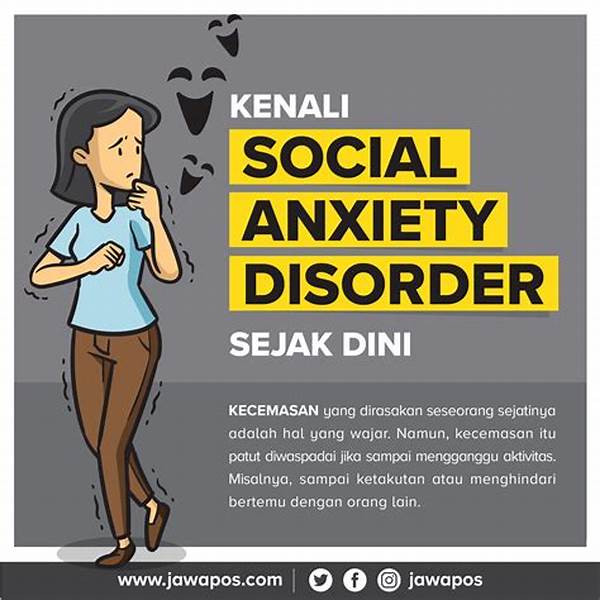In today’s fast-paced digital world, where everyone seems to be constantly connected and engaged, feeling comfortable in social situations is often regarded as a given. However, for millions across the globe, social interactions can be a source of overwhelming anxiety and stress. Social anxiety adalah a condition that affects countless individuals, creating barriers that impede everyday interactions. In this article, we will uncover the reality behind this often-misunderstood disorder, exploring its impact, symptoms, and the journey towards overcoming it. Whether you’re someone who might experience social anxiety yourself, or you’re looking to support a friend or family member, this exploration will provide valuable insights and practical advice.
Read More : Stop Avoiding: The Simple Exposure Technique That Cures Mild Phobias And Fears!
Social anxiety, also known as social phobia, is more than just shyness. It’s a chronic mental health condition that causes an irrational, intense fear of everyday interactions. This fear often leads to avoidance behaviors, negatively impacting personal and professional relationships. Social anxiety adalah a barrier to authentic communication, leading individuals to miss out on opportunities for connection and growth.
At the heart of social anxiety lies the fear of being judged, criticized, or humiliated in public. People with social anxiety may experience a range of symptoms, from blushing and sweating to trembling and a rapid heart rate when faced with social situations. These physical symptoms, coupled with the emotional stress, can heavily burden an individual’s mental health, leading to low self-esteem and even depression.
Despite the challenges posed by social anxiety, there is hope for improvement. Through therapeutic approaches such as Cognitive Behavioral Therapy (CBT), individuals can learn to manage symptoms and gradually shift their thoughts and behaviors. Medication and self-help resources, like mindfulness practices, also play a vital role in the journey toward recovery. Recognizing that social anxiety adalah a common struggle can empower individuals to seek help without stigma and embrace a life of more meaningful connections.
Understanding Social Anxiety Through Different Lenses
Social anxiety does not adhere to a one-size-fits-all model; its manifestations are as diverse as the individuals it affects. Social anxiety adalah more than just a singular experience, and understanding its multifaceted nature is key to fostering broader compassion and support.
Personal Stories and Testimonies
Emily, a junior in college, shares her battle with social anxiety: “Every time I have to present in class, I feel my heart racing, my palms sweat, and my mind goes blank. It’s the fear that everyone is watching and judging, which keeps me from participating fully in discussions and activities.” Such personal accounts highlight the real, lived experiences beyond clinical descriptions.
Social anxiety often arises from an interplay of genetic and environmental factors. Research shows that family history and childhood experiences contribute significantly to the development of social anxiety disorder. This insight stresses the importance of early intervention and supportive environments to mitigate its impact.
Cultural perceptions also play a role in shaping how social anxiety is experienced and addressed. In some societies, excessive shyness might be misconstrued as a lack of enthusiasm or competence, further exacerbating the anxiety of those affected. Educating communities about social anxiety adalah therefore essential in creating inclusive and understanding spaces.
By embracing these diverse perspectives, we can enhance our empathetic understanding and support for those navigating the challenges of social anxiety. In doing so, we can contribute to a world where everyone feels included and valued, irrespective of the fears they might face.
Breaking Myths About Social Anxiety
Misconceptions surrounding social anxiety abound—a common myth being that it’s merely ‘being shy.’ However, the reality of social anxiety adalah much more severe and pervasive than ordinary shyness, affecting people’s ability to function in everyday scenarios.
People with social anxiety are often labeled as introverted or anti-social, when in truth, many long for interaction but are deterred by overwhelming fear. Education and awareness can dismantle these myths, fostering a more supportive environment for those in need.
Similarly, it’s a misconception that people can just ‘get over’ social anxiety through willpower alone. Professional treatment and consistent self-help strategies are crucial for managing symptoms effectively. Assuring those with social anxiety that seeking help is a strength, not a weakness, is vital in changing the narrative surrounding the disorder.
Ultimately, acknowledging and addressing these myths not only alleviates individual struggles but also promotes a collective shift towards a compassionate understanding of mental health challenges. By debunking misconceptions, we pave the way for those with social anxiety to lead more fulfilling and less isolating lives.
Effective Approaches to Managing Social Anxiety adalah
Understanding that social anxiety adalah a complex condition requires a multi-faceted approach to management and recovery. Here are several strategies that have proven effective for many individuals:
While social anxiety poses significant challenges, these strategies demonstrate that managing and overcoming it is possible with dedication and support. By incorporating these approaches into daily life, those affected can move toward reclaiming their confidence and enhancing their quality of life.
Call to Action: Seeking Help and Support
If you or someone you know struggles with social anxiety, it’s crucial to recognize that help is available. Therapists, counselors, and mental health professionals are equipped with tools and insights to guide you through the process of healing. Social anxiety adalah a shared challenge, and seeking assistance is the first step toward transforming your relationship with social interactions. Don’t hesitate to reach out and explore the support systems that can foster growth, resilience, and connection in your journey.
This exploration into social anxiety highlights the significance of acknowledging and addressing mental health with empathy and informed strategies. Through increased awareness and accessible resources, we can create a more inclusive society that empowers individuals to face their fears and embrace their potential.
